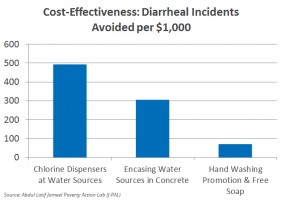IPA and NPR on Safe Water and Behavior Change
NPR’s Planet Money team had a great story on Morning Edition about clean water in Kenya and interviewed one of our field staff, Evan Green-Lowe about our Dispensers for Safe Water project.
The story didn’t include all the numbers, but the relevant comparison is that across multiple studies like this one, households who have chlorine available individually use it roughly 10% of the time, while the communal dispensers boost that number to over 40%.
They wonder why it isn’t 100%, but changing human behavior is hard.
I did an informal poll around IPA headquarters and found about 60% of us have bags of salad rotting in our fridges at home. At the grocery store, we have the best of intentions to eat healthily, but once we get home…
My office doesn’t seem to be alone, by the way. According to this report from the UK (PDF): “the food that is bought and then thrown away uneaten in the greatest proportion is salad; in the UK 45% by weight of all purchased salad is thrown away (60% by cost).”
Back in Kenya, Evan told Planet Money, "I've had malaria five times now … I have a bed net hanging above my bed, and I don't use it."
Human behavior is complex. All of us are fighting ingrained habits, the pressures of daily stress, limited attention spans, and the like. Given the number of factors influencing our behavior, most behavioral scientists are thrilled with even a small change – and IPA is very happy with the dramatic behavior changes we have been able to achieve in Kenya. The chlorine dispenser program has seen an increase in chlorination rates from very low levels to almost half of households with access chlorinating their water via dispensers right now. As the story concludes:
People everywhere — in rural Kenya, in New York, wherever — just don't always do all the things we're supposed to do. The developed world has solved the water problem by essentially taking people out of the loop: We pipe clean water to everyone's houses. But it's going to be a long time before that happens in rural Kenya.
 For now, taking people out of the equation isn’t realistic, but we’ve found that dispensers are the most cost effective broad scale solution at 50 cents per person at scale for a year’s supply (see this chart from J-PAL or the full brief here). We’re expanding the dispenser program to reach almost a million people, thanks to a new grant from USAID, and experimenting with new ways to boost usage of existing dispensers. For example we’re testing effect on usage from spreading the word through respected figures in each village, having community meetings before the dispensers are installed, and different combinations of incentives and SMS reminders to the people who promote the dispensers at the community level. We’re also learning from our dispenser operations in Uganda, where so far our pilots have been incredibly successful.
For now, taking people out of the equation isn’t realistic, but we’ve found that dispensers are the most cost effective broad scale solution at 50 cents per person at scale for a year’s supply (see this chart from J-PAL or the full brief here). We’re expanding the dispenser program to reach almost a million people, thanks to a new grant from USAID, and experimenting with new ways to boost usage of existing dispensers. For example we’re testing effect on usage from spreading the word through respected figures in each village, having community meetings before the dispensers are installed, and different combinations of incentives and SMS reminders to the people who promote the dispensers at the community level. We’re also learning from our dispenser operations in Uganda, where so far our pilots have been incredibly successful.
Once we hit on the magic formula to maximize safe water access, then maybe we’ll be able to do something about those vegetables hiding in the back of our fridges.











